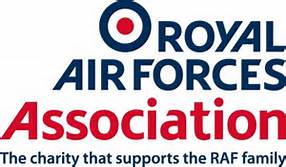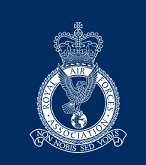BRANCH HISTORY
A HISTORY OF THE ROYAL AIR FORCES ASSOCIATION YORK BRANCH
Early Days.
In common with several newly formed Branches at the time, the York Branch of the RAF Association was conceived in a pub! On the 3rd of January 1946, a meeting was held in the Coach & Horses Inn in Jubbergate, under the auspices of Mr J W Atkinson. He explained that the purpose of the meeting was to form a local branch of the Royal Air Forces Association and it was agreed unanimously to proceed with the initiative, an ad hoc committee being elected.
Following the initial meeting, an inaugural meeting was held at the same venue on the 7th of February 1946, with 65 members being present. Mr H N W Pope took the Chair and the officers nominated at the meeting were confirmed. Mr J W Atkinson became the first Secretary, Mr F S W Johnson the Hon. Treasurer and Mr H E Hall the Hon. Welfare Officer. Sir Ivo Thompson became the Branch President. Shortly afterwards, an energetic start was made to fundraise for the Branch and several dances were arranged at the Clifton Ballroom and the De Grey Rooms. At this time, dances were extremely popular with many Branch members, but less so in more recent years sadly. Membership in the early days was relatively low, with the Chairman reporting in April 1946 that there were 170 members.
Growth & Consolidation.
At the August 1946 Committee meeting, things became somewhat heated regarding the issues of a lack of cooperation regarding the organisation of a garden fete. A heated discussion took place between many members culminating in a demand for the immediate settlement of accounts in respect of the garden fete. However, by September 1946, all appeared to have been resolved but all the officers and the Committee members resigned in order to enable new elections to take place.
In September 1946, the meeting agenda included a proposal that membership of the Branch be opened to members’ wives to enable them to take an active part in the Branch. Several members spoke against it and, on a vote, it was defeated. It took many years before things changed but we must remember that this was the 20th Century and not the 21st. “The past is a foreign country; they do things differently there.”
The Flying Services Club - a home of our own (almost).
Throughout 1946, meetings were held at the Coach & Horses pub in Jubbergate but there was a growing feeling amongst members that they should be able to meet in their own space. In November 1947, the Black Swan in Coney Street came on the market at £200 rent plus rates and the Branch members decided to go ahead and start the “Flying Services Club.” This involved considerable hard, physical work, including knocking down walls and rewiring the place, the latter being undertaken by Mr John Mawson. A dance was held at Terry’s Ballroom shortly after the opening of the Flying Services Club in April 1948.
Whilst there is no doubt that the Flying Services Club established the York Branch as a successful entity, the Club never really paid for itself and so it was closed down.
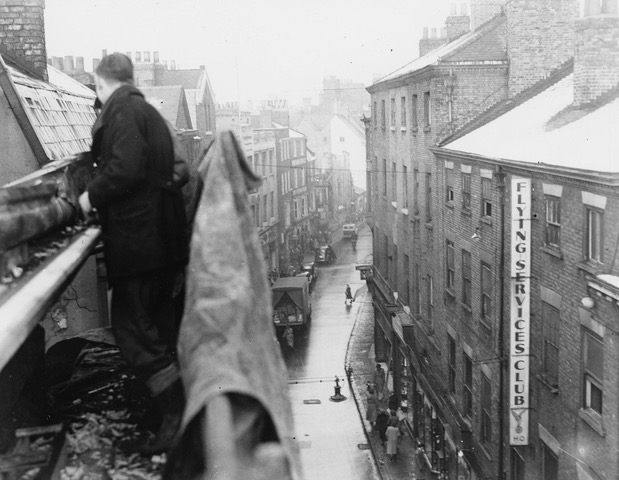
Coney Street on a wet day in the late 1940s with the large Flying Services Club sign prominent.
A permanent home is sought.
After the unfortunate closure of the Flying Services Club, members met in various pubs, including the Five Lions and the Londesborough. It was at a lively meeting at the latter venue on the 8th of January 1953 that it was proposed by Mr J Rainer and agreed that the Branch should look for new premises. During the following weeks, the then Secretary, Mr Alan Bott, scoured the streets of York until, in Aldwark, he spotted a board outside No 11 stating “To Let”. After a call to the agents, the property (three 18th century cottages) was considered to be “unfit for human habitation”. However, at a Branch Committee meeting on the 5th of February 1953, it was proposed and passed that the building should be acquired for the Branch. After considerable physical work, all by volunteer labour, the building was opened formally on the 16th of May 1953 by Alma Pope, wife of the then Branch President, Harold Pope. Funding for the purchase was aided by revenue from the popular weekly dances organised by the Branch which accrued over £1000, a considerable amount at that time.
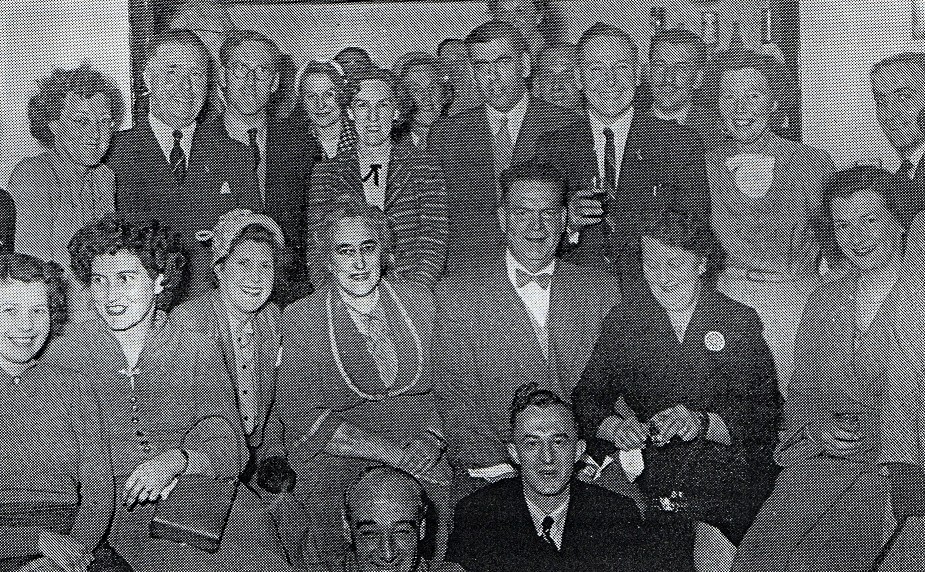
Opening Night at RAFA House Aldwark - 16 May 1953.
In the 1950s, Aldwark was not a particularly pretty sight in the environment around what is now RAFA House. Opposite the building was a slaughterhouse and pork pie factory and Pickford’s furniture warehouse was adjacent. The main advantage was, as it still is, that the location was in an excellent City Centre position, within York’s City Walls. The property was purchased with the aid of a loan from RAFA HQ, which the Branch repaid over time. Lord Esher’s 1969 plan for the redevelopment of Aldwark as part of his York “Study in Conservation” meant that the area improved throughout the 1970s and 1980s.
RAFA House Aldwark purchased.
In 1965, the Aldwark premises were purchased freehold for the sum of £1525, of which £1000 was borrowed from RAFA HQ. This was repaid as soon as it was feasible, and the building became the property of RAFA York Branch. However, as Branches and Branch Clubs cannot own property, the building is owned by RAFA HQ rather than by the Branch.
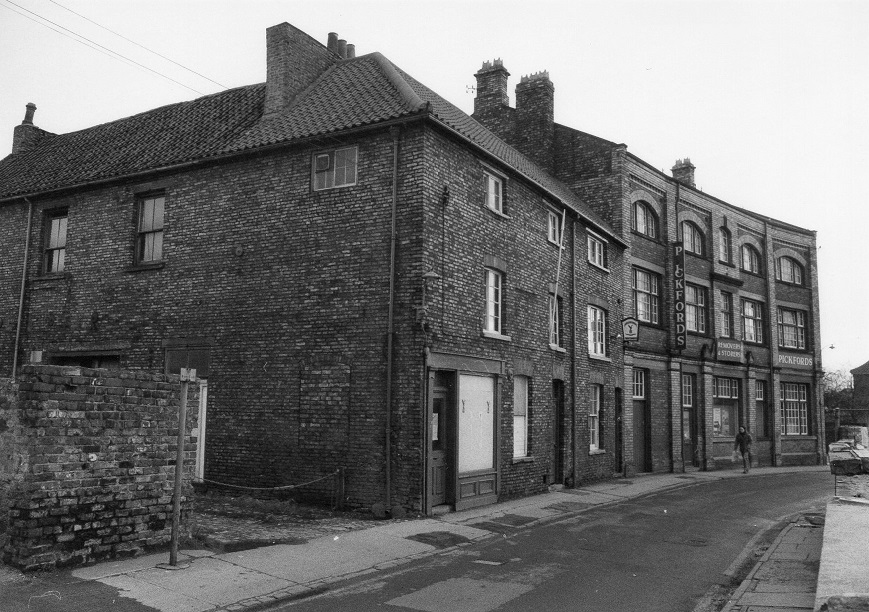
RAFA House in Aldwark in 1977, showing the old joiner's shop on the bottom left of the building which had been taken over by the Club. Note the adjacent Pickford's storage warehouse which was demolished in the 1980s.
Given the age of the building, it is not surprising that considerable work has been required to keep it safe, warm and attractive. In 1966, the building was reroofed, and further developments included the installation of a fitted kitchen on the second floor and new toilets were installed in 1977. The year 1980 saw a virtual rebuild of the premises, including much steel reinforcement and an additional skin for the outside walls. In 1988, the Branch celebrated its 35th anniversary at RAFA House, Aldwark and the late Alan Bott produced a booklet detailing the history of the Branch to commemorate this.
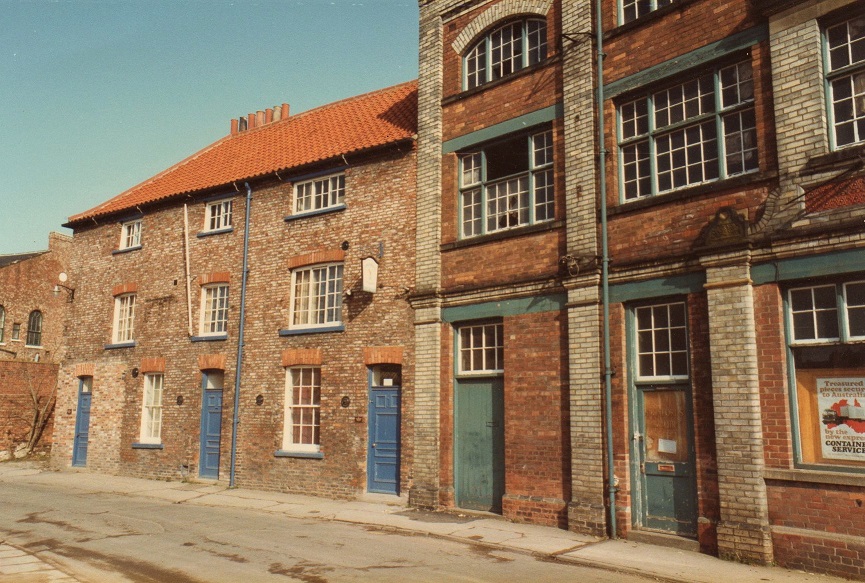
RAFA House circa 1980, after the old joiner's shop front had been removed and the building strengthened. The adjacent warehouse was demolished around 1984.
Traditions established.
In 1953, the Branch’s association with the RAF Memorial and Book of Remembrance in York Minster began. The memorial was dedicated in 1955 by the late Duke of Edinburgh, who was President of RAFA at the time. In 1960, the then Air Ministry decided that there should be a formal page turning ceremony of the Book of Remembrance to be carried out quarterly and RAFA York Branch members were invited to join the RAF contingent undertaking this honourable duty; this has continued to the present day.
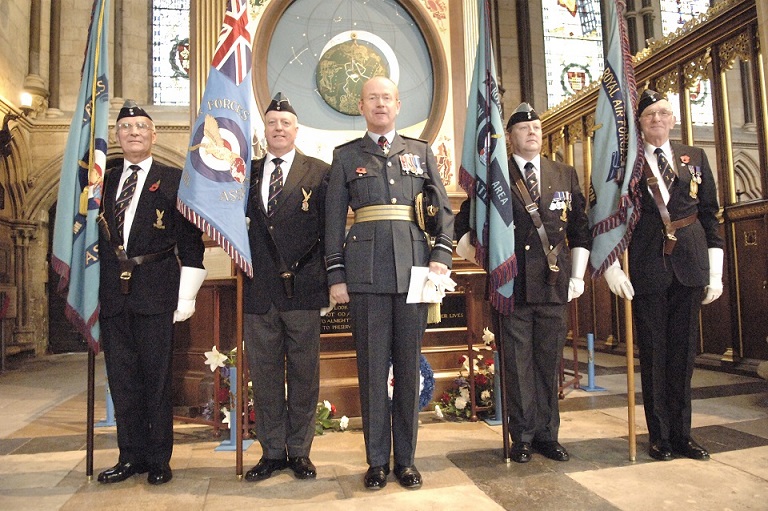
RAFA Standards (York Branch on left) in front of the Minster Astral Clock on the 50th Anniversary of its dedication in November 2005.
In 1954, York Branch acquired its first Branch Standard, which was dedicated at St George’s Church at Linton on Ouse on the 9th of May 1954. After many years of honourable use, the Standard was laid up in All Saints Church Pavement, York, where it still hangs from the Northern Wall. The replacement Standard was donated by Branch member Richard Harwood and dedicated in the same church by the Branch Chaplain at the time, Revd Canon Jack Armstrong.

A RAFA York Branch member with the Branch 50th Anniversary commemorative plaque in York Minster on 1 April 2005.
In 1961 the first Battle of Britain Golf Tournament was held at the Fulford Golf Club for the Deramore Cup. The Cup itself is still on display at the Branch Club. Unfortunately, the Battle of Britain Golf Tournament ended in 2017 after declining numbers wishing to partake in the competition.
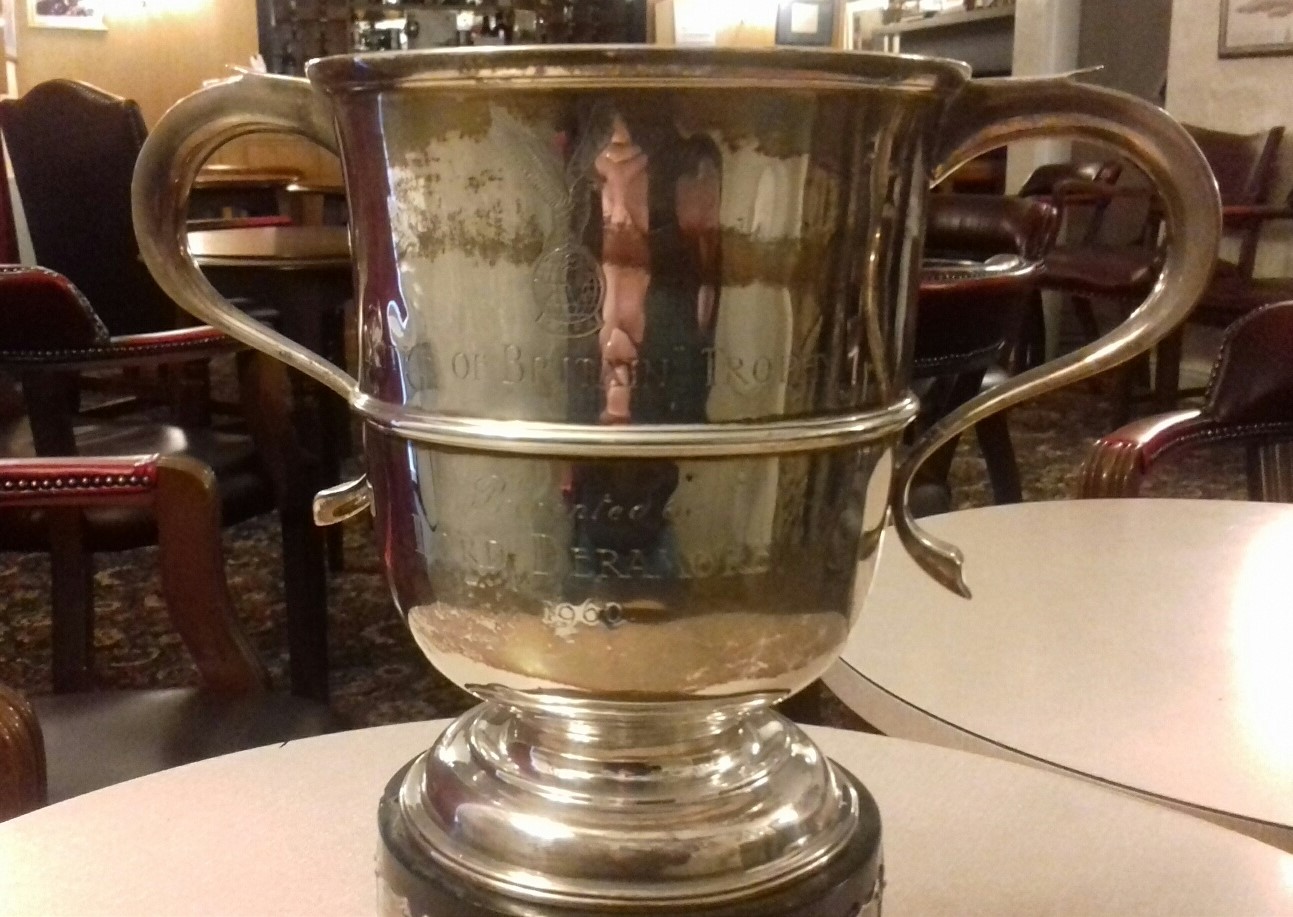
The Deramore Golf Cup - last won in 2015.
Into the next century.
By the turn of the 21st century, the Branch membership stood at over 370 and looked forward to the next major milestone in its history, a celebration of 70 years of fellowship. To mark the 70th anniversary of the founding of the York Branch in a fitting style, a formal dinner was held in the Belmont Room of Bettys Restaurant in York on Saturday 28 May 2016. The menu included a selection of Bettys famous cakes!
The guests of honour were Air Marshal Sir Graham Anthony “Dusty” Miller KBE RAF (Retd), the then National President of the Association and Group Captain Ian Laing ADC MA FRAeS RAF, the then Commanding Officer of RAF Linton on Ouse. The Branch Standard Bearer was Mr Ian Smith, and the Toast Master was Mr Brian Mennell, the then Vice-Chairman of RAFA York Branch. After the dinner, a national presidential certificate was awarded to Branch member Norman Spence for his work as the Branch Honorary Welfare Officer. (Norman died in January 2023). (See photo below of the "Top Table.")
Membership of the Branch remained very healthy for a while until the closure of the nearby RAF station at Linton on Ouse in December 2020, which resulted in a decline in serving RAF membership. Additionally, the increasing age of many members has meant that “Mother Nature” has also had a hand in reducing the membership. However, official RAFA figures in 2022 showed a good membership of around 400.
RAFA members at the Yorkshire Air Museum in October 2018.
Apart from a cessation of activities for most of 2020 and part of 2021 due to the COVID-19 Pandemic, Branch members have continued to represent the Association at a number of ceremonial events including the Escape Lines Memorial Society Service at Eden Camp near Malton, the RAF East Moor remembrance ceremony at Sutton on the Forest and the November ceremonies in York. Additionally, Branch members have visited a number of locations of interest to members of the RAF Family including RAF Linton on Ouse (prior to its sad closure in 2020), RAF Leeming, the National Memorial Arboretum and the Yorkshire Air Museum at Elvington.

The RAFA York Branch Wings Appeal Stall - 2019.
Efforts have continued to maintain and improve the Branch HQ at RAFA House. Since 2015, for example, work carried out has included the insulation of the roof space, the installation of a very efficient ventilation system to eliminate damp and a more efficient heating system. A new carpet was also fitted in the second-floor dining area.
In January 2023, a new sign, in the form of the building's address, in black lettering, was fixed to the fanlight glass area above the main entrance. This replaced the previous RAFA old badge sign, which had deteriorated considerably. In July 2023, a new hanging sign, with the current RAFA badge, was purchased, and installed by Dick Gray and Bob Webster. Both are small, but significant additions to the exterior. During the same period, more of the guttering was replaced.
Back in 2016, York Branch celebrated the 70th anniversary of its formation. Even then, the World was a very different place from 1946, and the Royal Air Force was a much smaller Service in 2016 compared to 1946. However, the spirit of camaraderie remains into the second decade of the 21st Century and will doubtless continue. We will see what 2026 may bring!
RAF ASSOCIATION YORK BRANCH PRESIDENTS.
1946-1947 Sir Ivo W H Thomson Bt.
1948-1956 Mr H H W Pope.
1957- 1965 Canon N F Porter BA LTh.
1966-1976 Air Commodore R H Crompton OBE BA.
1977-1994 Wing Commander E B Symonds.
1995-2001 Canon J H Armstrong OStJ BA Dip Th.
2001-2011 Air Commodore W G Gambold FI Mgt.
2011-2012 Mr K D Whitfield.
2013-2019 Flight Lieutenant J J Mawson RAF(VR) Ret.
2019- to date Flight Lieutenant R W Gray RAF(VR) Ret.
RAF ASSOCIATION YORK BRANCH CHAIRMEN
1946 H H W Pope
1947 J Greenwood
1948 J S Edwards
1949 K Henderson
1950 E Hibberson
1951 G Addymam
1952 W Morrow
1953-1955 J Bradshaw
1956 F Searby
1957 P E Robinson
1958-1961 D J Davies
1962-1963 K D Whitfield
1964 R Pennock
1965 D Bull
1966 R Harwood
1967 R Mathieson
1968-1970 J Winter
1971 G A Calvert
1972-1973 J Sloan
1974-1976 H N Cowan
1977-1979 A Cofield
1980-1981 A K Bott
1982-1984 Mrs L M I Cofield
1985-1986 A W Eyeington
1987 K D Whitfield
1988-1989 N O White
1990 R A Howat
1991-1993 G A Calvert
1994-2001 J Sloan
2002-2005 H R Kidd
2006 K D Whitfield
2007-2010 J H Allison
2011-2013 Ms S Richmond
2014-2016 R W Gray
2017-2021 B R Mennell
2022 to date A M Bryne
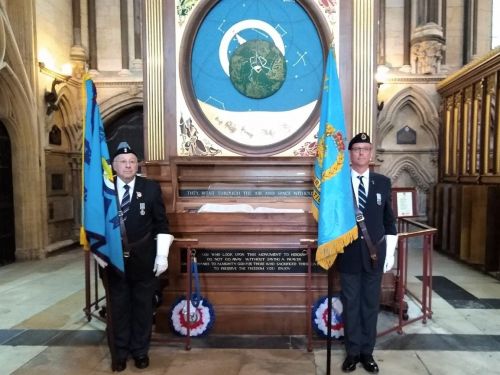
THE YORK MINSTER ASTRONOMICAL CLOCK.
“Dying and Behold we Live.”
Four times a year, members of the York Branch of the Royal Air Forces Association, together with Royal Air Force personnel from North Yorkshire, carry out a special ceremony in front of an astronomical clock in York Minster. In front of the clock is a large book of remembrance, containing the names of over eighteen thousand Service personnel who gave their lives in the Second World War while operating from air bases in Yorkshire, Northumberland and Durham. Most were members of the Royal Air Force but over 3000 belonged to the Royal Canadian Air Force and others to the Royal Australian, Royal New Zealand and the South African Air Force. The Book also contains the names of Belgian, Dutch, Free French, Norwegian, Czech and Polish airmen who also died while serving the Allied cause from this area.
Whilst the focus of the ceremony centres around the turning of a page of this book of remembrance by a member of the RAF and the RAF Association, the history and significance of the Astronomical is well worth examination. Hidden in the North Transept of York Minster, the clock depicts the motion of the Sun and stars around a map of the city of York at the centre, with the Minster highlighted in gold leaf. As the Minster is so large and elaborate, it would be quite easy for someone to visit the cathedral without ever noticing the clock. The clock was first conceived in 1944 and designed by Robert d'Escourt Atkinson, chief assistant at the Royal Greenwich Observatory. Atkinson based the design on the appearance of the sun and stars from the viewpoint of a pilot flying over York. The mechanism and two dials were constructed by A C S Westcott and Royal Greenwich Observatory craftsmen and installed in the north transept of York Minster in 1955, next to the famous Five Sisters window on one side and the Women’s Memorial of the First World War on the other.
On the 1st November 1955, (All Saints Day) in the presence of a notable gathering of the next-of-kin of fallen airmen, and representatives of Commonwealth governments and Her Majesty’s air forces, H R H the Duke of Edinburgh unveiled the beautiful shrine erected as a memorial to the fallen of Nos 4 (Bomber), 6 (RCAF Bomber) and 7 (Operational Training) Groups of Bomber Command, Nos 16 and 18 Groups of Coastal Command, and units of RAF Fighter Command – including Nos. 607, 608, 609 and 616 Auxiliary Squadrons.
Between 4,000 and 5,000 persons attended the dedication ceremony and took part in this memorable service of thanksgiving held in York Minster; a church familiar and, indeed, a symbol to airmen of many lands – Britain, Canada, Australia, New Zealand, France, Norway, Poland, Czechoslovakia, and the Low Countries – all gathered in Great Britain to fight for freedom and democracy. Outside the Minster, a march-past of RAF and RCAF personnel, supported by members of the RAF Association and the British Legion took place, with H R H The Duke of Edinburgh taking the salute. A reception, by invitation, was held in the famous York Assembly Rooms. It is notable that the Royal Canadian Air Force Association raised approximately $9,000.00 towards the cost of the Astronomical Clock.
The Book of Remembrance is encased in a glass case at the front of the Astronomical clock. The names of the fallen are written in one long list, in alphabetical order, and are grouped in blocks under the initial letter of surnames. They are not grouped by commands, formations, or units. This makes for ease of reference. There are vacant spaces such as occur at the end of a block of names grouped under their key alphabetical letter. These spaces have been filled in with exact drawing reproductions of the different types of aircraft flown by the airmen named in each block of names proceeding the drawings. Famous types in their day, these aircraft are already all but forgotten as regards design and appearance, except by those living who have flown them. The Book of Remembrance, therefore, gains in historical importance by accurately listing and depicting these aircraft, which include: Avro Anson, Bristol Beaufort, AW Whitley, Vickers Wellington, Short Stirling, Vickers Warwick, Short Sunderland, Fairey Battle, Hawker Typhoon, DH Mosquito, Supermarine Spitfire, Supermarine Walrus, Bristol Blenheim, Bristol Beaufighter, Avro Lancaster, Hawker Tempest, Miles Master, Gloster Meteor, HP Halifax, DH Tiger Moth, Westland Lysander, NA Mustang and Consolidated Catalina.
